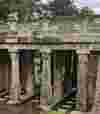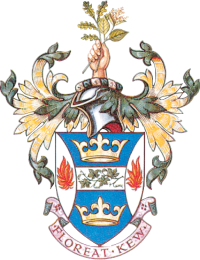Cotswolds Visit, June 2025
Events / 1st Aug 2025
To create a worthy Kew Guild visit to follow on from the joint tour to Tuscany with the Bournemouth U3A in April-May was no mean task. But we had no need to worry as we were in the most capable hands of our long-standing organiser of Kew events, Pamela Holt. Also, what better place is there to visit in the early English summer than the lush rolling landscape of the Cotswolds?
On 25th June, we headed there for a two-day visit to a pair of privately owned, quintessential English estates that are traditionally managed and boasted large houses and high quality gardens. Although geographically located in the same area and largely built or remodelled during the 18th/19th centuries, it would be very difficult to find two more dissimilar houses to savour than Sezincote and Rousham House.
The choice of venues was inspired, the weather was good, the company superb and the tour immaculately organised, just as one would expect from a visit arranged by the Kew Guild.
Sezincote
Sezincote was a surprise to us all as we drove beneath the mighty oaks along the entrance drive on a bright early summer morning. We knew that it was a tranquil English Estate of some 3500 acres and there were strong links with Mughal architecture and culture. This however, did not prepare us for the feast to the eyes of the house and gardens.
The house was designed by Samuel Pepys Cockerill, built in 1805 and is a fine example of Neo-Mughal architecture with its reinterpretation of 16th/17th century designs from the Mughal Empire. The building is of impressive red sandstone, typical of that architecture, but we were not expecting the large copper covered ‘onion’ domes and the minarets, which caught the morning sunlight.
The tour of the house was fascinating, showing that the internal design did not echo the external influence of Mughal architecture. It is designed in a mix of Greek and British Imperial/Classical style with luscious rugs, carpets and family portraits, like so many other large English homes. Attached, is the impressive curved Orangery with its collection of tender plants adding to the Mughal feel and relaxed environment. This used to be the home of exotic birds but is now the site of the café which is as good as any in the Cotswolds with its delightful views and extraordinarily good cakes and pastries. We were not the only visitors, over time, to be enthralled by the delights of a visit to Sezincote. It is credited that after a visit by the Prince Regent in 1807, he was so impressed that he changed his plans for the design of the Brighton Pavillion and the similarities are obvious.
The house overlooks the fine gardens designed with the help of Humphrey Repton. The southern parts, laid out as a Persian garden, are enclosed by Irish Yews and the Orangery and include the Canal and Fountain Garden interspersed with columns of clipped Yew. With the little pavilion, built in Indian style and the pair of stone elephants, the layout, restored in the late 1960’s is evocative of Mughal paradise gardens. The larger garden, to the north and east of the house has a far more relaxed feel, designed along the 250m of stream that feeds the various pools as it tumbles to the valley bottom, before joining the River Evenlode. The garden starts with the Temple to Surya, the sun god, overlooking the Temple Pool which is continuously fed by a spring. Here the stream starts its fall through the Thornery to pass under the Indian Bridge, which carries the main drive to the house and is adorned with fine bronze Brahmin bulls. Beyond the bridge, the stream enters the Snake Pool, with its elaborate statue of a snake coiled around a column, situated on a small island.
At this point the gardens start to broaden out and become home to a wide range of bog loving plants, including impressive clumps of Gunnera manicata, Lysichiton americanus and camtschatcensis along with Osmunda regalis. To add a final piece of horticultural drama the garden is framed with an impressive stand of Cedrus libani and various species of Catalpa along with an artistically placed Carpinus betulus pendula.
The final chapter in the stream’s journey to the river is the large island pool with its peaceful surrounds, bridges and attractive plantings of shrubs and small trees. In all, a remarkable garden that was the perfect end to our visit to Sezincote that will be long remembered.
I do not think that there can be a more fitting description of Sezincote than that in John Betjeman’s poem in his ‘Summoned by the Bells’ collection. ‘Down the drive, Under the early yellow leaves of the oaks, the bridge, the waterfall, the Temple Pool and then they burst on us, the onion domes.’
Review by Alan Stuttard.

Indian bridge with Brahmin bulls

Columnar clipped yews and stone elephants
Rousham House
Our thanks to Pamela for organising this trip. A select group of us met to enjoy this country estate in the East Cotswolds. We were greeted with the sign “NO CHILDREN UNDER 15. NO DOGS”.
A tour of the house to start with in the morning. We had a most interesting guided tour round Rousham House. It is not a grand estate house but more of a large country house. Originally built by Sir Robert Dormer in the 1630’s but construction was halted by the English Civil War. The Dormers were Royalist and the house was attacked by Parliamentary soldiers. The original front door, still in place today has three small loopholes to enable defenders to fire muskets on the attacking Parliamentarians.
In 1649 the estate was inherited by Sir Robert Dormer’s son, also called Robert, who left the house much as his father had created it. However he did restore the family fortunes by marrying twice, each time to an heiress. His second wife was the daughter of Sir Charles Cottrell who was Master of Ceremonies (Head of the Diplomatic Service for Charles I and Charles II). His portrait hangs in the house with him wearing his badge of office – a jewelled pendant on one side a peacock showing when the country was at peace, the other side a dagger when the country was at war.
The remodelling of the house by William Kent began around 1738 when the estate had been inherited by General James Dormer. Kent transformed the house into something vaguely resembling an early Tudor palace in free Gothic style. Kent also redesigned and decorated some of the interior rooms. The most interesting being the Painted Parlour and the Great Parlour. The Painted Parlour was one of the most exquisite small rooms in 18th Century England. The carved brackets on the walls were designed by Kent to display the General’s collection of Italian bronzes. The Great Parlour was originally the General’s library but later transformed into a room for grand entertaining with a small conservatory to one side. The General’s books, mainly first editions, were auctioned off in a four day sale!
The house remained largely unchanged until the 1860’s when it was extended to the rear by William St. Aubyn who followed Kent’s original style. The octagonal glazing was replaced by sash windows. However some of the original octagonal glazing was found in an estate barn and has been restored to it’s original windows as designed by Kent.
The Cottrell-Dormer family still own the house and estate and live in the house which is only open for guided tours for parties of 10 or more. It contains many fine family portraits and a collection of Jacobean and 18th Century furniture. Kent’s signature scrolls and shells are evident throughout.
The view of the estate from upstairs in the house was magnificent. The Bowling Green lawn was being mown as we watched – the immaculate stripes lined up with the main entrance steps to the house and the Lion and Horse statue at the far end. The eye was drawn beyond the River Cherwell to the distant Temple of the Mill and beyond that to the Sham Ruin on the horizon. Breathtaking. This to be enjoyed at ground level after lunch.
Time before that just to wander through the small nursery (a lovely collection of Pelargoniums) to see the formal gardens (Box and Verbascum) and the walled gardens which supply the house with fruit, veg and flowers. We had been greeted with a wonderful arrangement of flowers on the hall table when we arrived.
No cafe, no shop, no rain so we picnicked in this sheltered part of the gardens. Worthy of note is that bordering the walled garden, on the other side, was a cloud-clipped Yew hedge. The yews were originally very precisely clipped but had collapsed under the weight of snow and are now managed in a less formal, but still very pleasing manner.
Then the William Kent landscape garden. We appreciated all the delights – cascades and ponds in the Venus Vale, the seven-arched portico (Praeneste), the many statues, lawn walks and woodland paths. It was a joy to be able to wander in peace through these wonderful gardens. But just one problem. On reading the Rousham Park guide book retrospectively I realise that “To appreciate Kent’s ingenuity it is important to make the circuit of the garden in the direction he intended”. Oops! This I had not done. Will have to go again!
Review by Andrew Fisher (the house) and Tricia Fisher (the garden).

Rousham House walled garden
More articles
-

Visit to Birmingham Botanic Gardens
Events / 25th Nov 2025
-

Seventy odd years agrowing – some of them odd indeed
Insights / 13th Aug 2025
